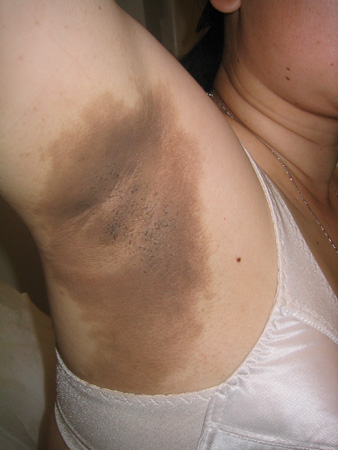Differentials
21-hydroxylase deficiency
SIGNS / SYMPTOMS
Partial deficiency of the 21-hydroxylase enzyme within the cortisol biosynthetic pathway results in accumulation of androgenic precursors.
Clinical presentation may be indistinguishable from that of PCOS.
Certain ethnic groups are at risk: Yupik Eskimos, Ashkenazi Jews, and Hispanic, Italian, and Yugoslav women.
Very rare in African-Americans.
INVESTIGATIONS
A morning, follicular-phase 17-hydroxyprogesterone level <6 nmol/L (<200 ng/dL) rules out the disorder. A value >24 nmol/L (>800 ng/dL) rules it in. Intermediate values prompt cosyntropin (adrenocorticotrophic hormone) stimulation testing.
Women with non-classic congenital adrenal hyperplasia always have a stimulated (60 minutes) 17-hydroxyprogesterone value >30 nmol/L (>1000 ng/dL) (usually >45 and <303 nmol/L or >1500 and <10,000 ng/dL).
Thyroid dysfunction
SIGNS / SYMPTOMS
Thyroid dysfunction may lead to menstrual irregularities. However, unlike in most cases of PCOS, hyper-androgenism is absent.
Clinical features of hypothyroidism (e.g., lethargy, cold intolerance) or hyperthyroidism (e.g., weight loss, nervousness, heat intolerance) may be present.
INVESTIGATIONS
Thyroid-stimulating hormone level greater (primary hypothyroidism) or less than (hyperthyroidism) the normal range.
Hyperprolactinaemia
SIGNS / SYMPTOMS
Hyperprolactinaemia may lead to infrequent or absent menses.
Mild hyper-androgenic features may be observed.
Galactorrhoea is usually present.
There may be headache or visual field deficit.
INVESTIGATIONS
Prolactin level greater than the upper limit of the normal range. However, some women with PCOS have prolactin levels that are slightly elevated.[2]
Cushing's syndrome
SIGNS / SYMPTOMS
Circulating cortisol and androgen levels are elevated, resulting in obesity, hirsutism, acne, and menstrual irregularity.
Usually with moon facies, central fat deposition, hypertension, muscle wasting, abdominal striae, and osteoporosis.
Adrenal carcinomas in particular are inefficient at synthesising cortisol and can release large amounts of androgenic precursors, leading to severe hirsutism and virilisation.
INVESTIGATIONS
Screen for Cushing's syndrome with 24-hour urinary free cortisol (normal <248 nmol/24 hours [<90 micrograms/24 hours] for radio-immunoassay or <138 nmol/24 hours [<50 microgram/24 hours] for high-performance liquid chromatography) or low-dose dexamethasone suppression test (e.g., overnight: 1 mg at 11 p.m. or midnight), with 8 a.m. plasma cortisol the next morning. Normally a.m. cortisol is suppressed to <138 nmol/L (<5 micrograms/dL) (<50 nmol/L or <1.8 micrograms/dL with modern cortisol assays sensitive to detect 28 nmol/L (1 microgram/dL)). An alternative screening test is late p.m. salivary cortisol.
Androgen-secreting neoplasms
SIGNS / SYMPTOMS
These are steroid-producing tumours of the adrenal or ovary.
Autonomous androgen production often produces rapid-onset (within months) progressive virilisation (frontal balding, severe hirsutism, increased muscle bulk, deepened voice, clitoromegaly).
INVESTIGATIONS
A baseline total testosterone >6.9 nmol/L (>200 ng/dL) (or free testosterone >0.7 nmol/L [>2 ng/dL]) warrants ultrasound of the ovaries (but may miss small hilus cell tumour).
Dehydroepiandrosterone sulfate >7000 ng/mL should prompt CT scan of the adrenals.[75]
Some androgen-producing tumours may be associated with serum testosterone <6.9 nmol/L (<200 ng/dL).
Most women with testosterone >6.9 nmol/L (>200 ng/dL) have PCOS or hyper-androgenism-insulin resistance acanthosis nigricans syndrome. The rapidity of onset of virilisation (<2 years) or onset late in life is a better predictor of neoplasm than androgen levels.[76]
Syndromes of severe insulin resistance
SIGNS / SYMPTOMS
Degrees of insulin resistance, hyperinsulinaemia, and hyper-androgenism tend to be more severe than in PCOS.
Also known as hyper-androgenism-insulin resistance acanthosis nigricans syndrome. [Figure caption and citation for the preceding image starts]: Acanthosis nigricans involving the axilla of an obese white womanFrom the collection of Melvin Chiu, MD, UCLA; used with permission [Citation ends].
Lipodystrophy may be present.
INVESTIGATIONS
Diagnosis is based on fasting insulin >556 picomol/L (>80 micro-units/mL) and/or peak insulin >2084 picomol/L (>300 micro-units/mL) during a 3-hour 75 g oral glucose tolerance test, provided that beta cells are functional (reflected in normal glucose levels).
Androgenic/anabolic drugs
SIGNS / SYMPTOMS
History of use or abuse of testosterone, anabolic steroids, danazol, dehydroepiandosterone, androstenedione, 19-norprogestins, norgestrel, levonorgestrel, or norethisterone.
Severity of hyper-androgenism varies depending on dose and duration of drug use.
INVESTIGATIONS
Depending on agent used, blood evaluation for androgen levels may or may not be diagnostically useful.
Hypogonadotrophic hypogonadism
SIGNS / SYMPTOMS
Presents with oligo-anovulation, but hyper-androgenism is absent.
INVESTIGATIONS
Low serum follicle-stimulating hormone and estradiol.
Premature ovarian failure
SIGNS / SYMPTOMS
Presents with anovulation, but hyper-androgenism is absent.
INVESTIGATIONS
High serum follicle-stimulating hormone and low serum estradiol.
Apparent cortisone reductase deficiency
SIGNS / SYMPTOMS
Functional decrease in 11-beta-hydroxysteroid dehydrogenase type 1, leading to decreased conversion of inactive cortisone to cortisol.
As a result of enhanced peripheral clearance of cortisol, there is less feedback suppression of adrenocorticotrophic hormone, resulting in adrenal androgen excess.
Clinically may be indistinguishable from PCOS.[77]
INVESTIGATIONS
Ratio of tetrahydrocortisols to tetrahydrocortisone is very low (0.04 to 0.08, normally 0.5 to 2.0).
Both adrenals often enlarged.
Urinary free cortisol may appear elevated.[77]
Use of this content is subject to our disclaimer